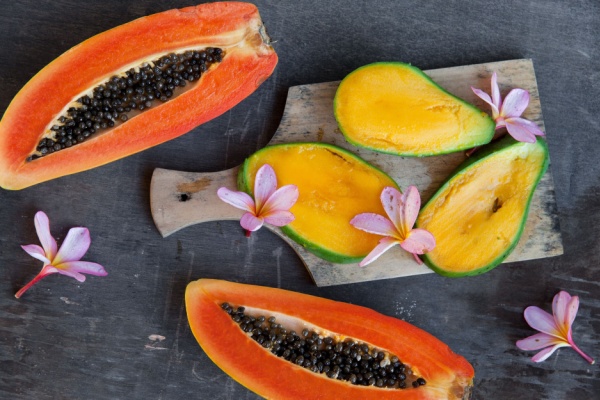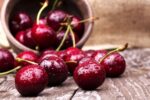 June is National Papaya Month AND Mango Month – Celebrate these Delicious and Nutritious Tropical Fruits!
June is National Papaya Month AND Mango Month – Celebrate these Delicious and Nutritious Tropical Fruits!
June is both National Papaya AND National Mango month. Not only are these tropical fruits beautiful to look at and delicious to eat, they’re packed with a bunch of health benefits, too!
All about the PawPaw
Papaya, also called papaw or pawpaw, is a succulent fruit of a large plant of the family Caricaceae. Though its origin is rather obscure, the papaya may represent the fusion of two or more species of Carica native to the lowlands of Mexico and Central America, with evidence suggesting cultivation by ancient civilizations like the Maya and Aztecs, who also cultivated the leaves, seeds, and sap of the papaya for various purposes, including medicinal applications.
The Spanish were instrumental in introducing papaya to Asia, particularly the Philippines, in the 16th century. From these early introductions, papaya cultivation spread throughout Asia, Africa, and the Caribbean, with Mexico remaining a major producer. Today it is cultivated throughout the tropical world and into the warmest parts of the subtropics.
The papaya fruit is slightly sweet, with an agreeable musky tang, which is more pronounced in some varieties and in some climates than in others. It is a popular breakfast fruit in many countries and is also used in salads, pies, sherbets, juices, and confections. The unripe fruit can be cooked like squash. Ripe papaya is delicious in sweet or tropical dishes (like salsa or salads) whereas green (unripe) papaya is often used in Thai or other Asian cooking.
Healthy and low fat, papayas are rich in Vitamin C, A, Folacin and B6. Papaya also contains an enzyme called Papain that is used in meat tenderizers because of its ability to break down tough fibers. For this reason it’s considered a great natural digestive aid.
Did you know?
- Papayas were referred to as the “fruit of the angels” by Christopher Columbus.
- Papayas are grown on trees that have big, palm-like trunks.
- While papaya seeds are edible, they’re quite peppery and bitter so it’s best to remove them.
- The most popular papaya is the solo or Hawaiian variety. Most papayas are approximately 6 inches long and weigh between 1 and 1.5 pounds, but can range up to 20 pounds.
- They are greenish-yellow skinned but have a bright orangey red flesh. Ripe fruit has more yellow than green coloring and yields to gentle pressure.
- To ripen papayas, store at room temperature in a loosely closed paper bag. Cover and refrigerate ripe fruit for up to one week.
Mangolicious
Mangoes are considered a stone fruit, like plums, cherries and peaches. Botanically, a mango is a “drupe,” consisting of an outer skin, a fleshy edible portion, and a central stone enclosing a single seed.
According to mango.org, the Mangiferi indica (meaning “an Indian plant bearing mangos”) were first grown in India over 5,000 years ago, where they were also used widely for their medicinal benefits. Mango seeds traveled with humans from Asia to the Middle East, East Africa and South America beginning around 300 or 400 A.D. Spanish explorers brought mangos to South America and Mexico in the 1600’s. The first attempt to introduce the mango into the U.S. came in 1833 to Florida.
Mangoes are known for having a delightful combination of sweetness and tanginess. It’s a subtle acidity that balances the sweetness, providing a refreshing and tangy element. The texture is typically soft and smooth, with the flesh being juicy and can also be slightly fibrous. They can be used in a wide variety of ways, both in sweet and savory dishes, including blended into smoothies, pies, ice cream, salads, salasas, curries and chutneys and are often used to great effect in giving a tropical element to cocktails.
Mangoes offer a wide array of health benefits due to their rich nutrient profile. They are a good source of vitamins A and C, important for immune function and skin health. Mangoes also contain antioxidants like mangiferin, which may help protect against certain diseases and reduce inflammation. Additionally, their fiber content supports healthy digestion and can help regulate blood sugar levels.
Did you know?
- The paisley pattern, developed in India, is based on the shape of a mango.
- A basket of mangos is considered a gesture of friendship in India.
- The mango is a symbol of love in India.
- Legend says that Buddha meditated under the cool shade of a mango tree.
- Mangos are related to cashews and pistachios.
- Mango bark, leaves, skin, flesh and the pit have been used in folk remedies for centuries.
—
Photo Credit: Yolya Ilyasova / Shutterstock.com







